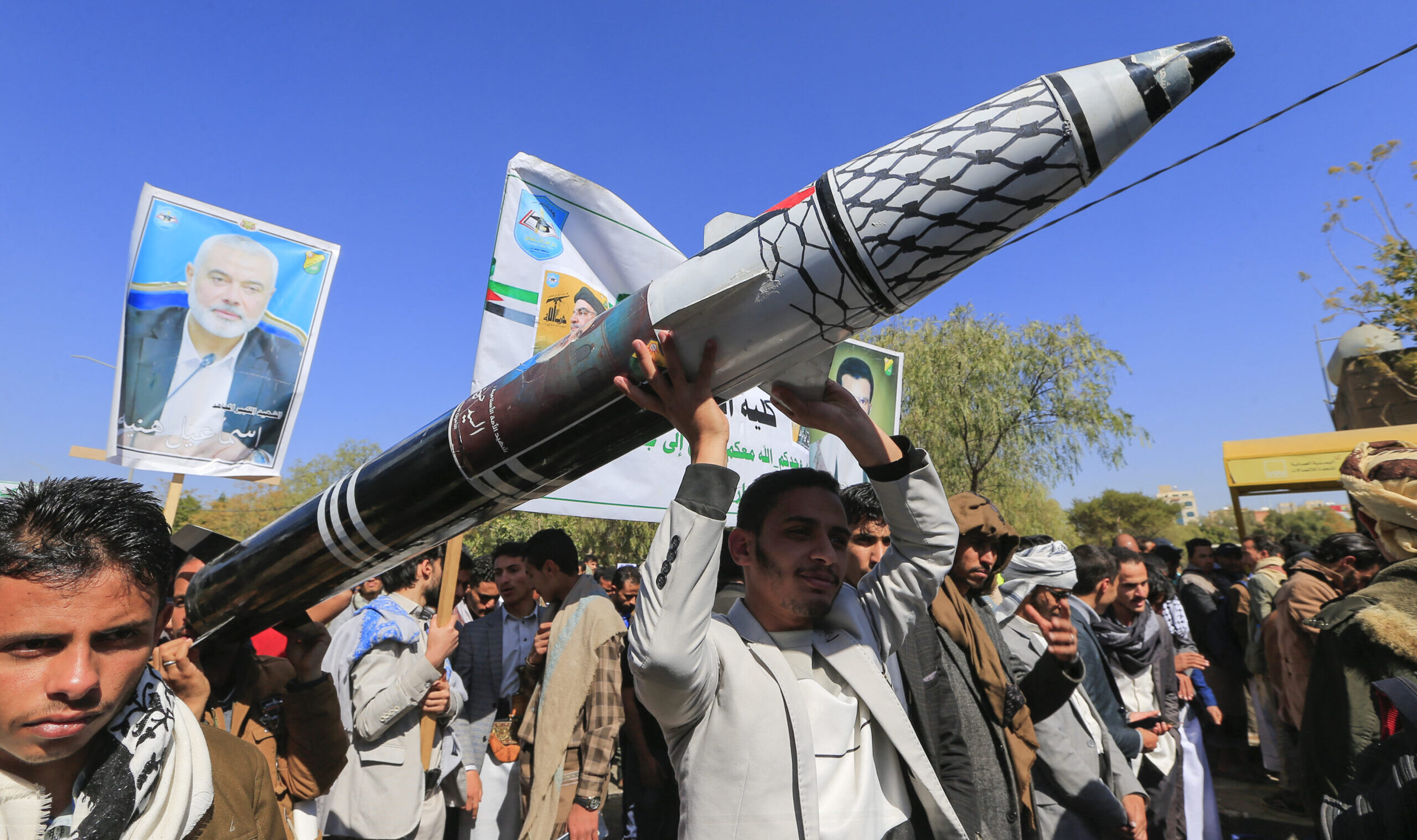Why Let the Houthis Bleed Our Military Stockpiles?
When DoD insiders are worried, you know something is wrong.

It is one thing for critics of U.S. military interventions abroad to say that a bombing campaign against the Houthis is wasteful and could put national security at risk—it’s another when military officials and their supporters in Congress say so.
Chalk it up to the growing understanding that Washington may be expending too many precious weapons on a small militant group with a history of outlasting its much bigger and more powerful adversaries. Chalk it up, too, to powerful interests inside the national security community that want Washington to refocus its American military assets away from the draining conflicts in Ukraine and the Middle East and toward the Indo-Pacific.
According to the New York Times, “Pentagon officials have told allied counterparts, lawmakers and their aides in closed briefings that the U.S. military has had only limited success in destroying the Houthis’ vast arsenal of missiles, drones and launchers.” Moreover, “a senior Defense Department official recently told congressional aides that the Navy and the Indo-Pacific Command were ‘very concerned’ about how fast the military was burning through munitions in Yemen, a congressional official said.”
This comes only days after news that the DoD was deploying six B-2 stealth bombers—30 percent of the U.S. stealth bomber fleet—plus supporting aircraft and a Nimitz-class carrier, the USS Carl Vinson, to join the USS Truman carrier group in the Indian Ocean.
These concerns are not new. The military is burning through its stockpiles, and has been since the Russian invasion of Ukraine and the Biden administration’s insistence that the U.S. give Kiev “whatever it takes” to win the war there.
“Regardless of the merits or demerits of the Biden administration’s policies on the wars in Ukraine and Gaza and the wider Middle East, it has become clear that the United States has been using and giving away its missiles faster than it can produce them,” argued defense analyst Michael Fredenberg late last year. “It is also clear that from the perspective of missile inventories and production, the United States is far from prepared to engage confidently in a sustained direct conflict with a peer competitor like China.”
Since October 2023, when the Houthis began striking Israel-linked merchant ships in the Red Sea and threatening a blockade over what they said was Israel’s collective punishment of Palestinians in Gaza, the U.S. Navy has led “Operation Prosperity Guardian”—more or less by itself—expending more missiles and ammunition in conflict than at any time since the Second World War.
According to Jim Fein at the Heritage Foundation, the U.S.—as of August of 2024, before the most recent anti-Houthi campaign under President Trump—had fired 125 Tomahawk missiles, representing more than three percent of its Tomahawk arsenal, at the Houthis.
Meanwhile, according to his math, the maximum number of standard missiles in the U.S. inventory (the exact amount is classified) is 11,000. As of his report in August, the U.S. had fired 155 standard missiles, constituting about one percent of the maximum U.S. inventory, but probably closer to two percent “due to arsenal age and attrition.” Depending on the variant, standard missiles can cost from $2 million to $12 million per unit to build.
“In a war against China, these munitions are critical,” Fein wrote. “The Houthis are a comparatively small, less advanced, and less lethal threat than China, yet they’ve proven to be a persistent problem for the U.S. and its allies. If it takes hundreds of missiles to blunt Houthi attacks—with limited success—it will take even more to face the threat from China.”
He also points out that “expending munitions against the Houthis would be less damaging if the U.S. was backfilling those munitions in a timely manner. But we’re not.”
In January we got a better picture of all the weapons fired. According to Vice Admiral Brendan McLane, the Navy’s surface fleet had fired nearly 400 individual munitions while battling the Iran-backed Houthis in the Red Sea over the previous 15 months. That includes 120 SM-2 missiles, 80 SM-6 missiles, 160 rounds from destroyers’ and cruisers’ five-inch main guns, and a combined 20 Evolved Sea Sparrow Missiles (ESSM) and SM-3 missiles.
When the Trump administration secured the surprising ceasefire in Gaza in January, the Houthis did what they said they would do and stopped attacking ships. They began again when Israel broke the ceasefire and resumed its bombing and land incursions into the Strip. Washington responded by unleashing more widespread attacks on Houthi targets than the Biden strikes last year. For a month now, the U.S. military has been pummeling Yemen’s port areas and other alleged Houthi targets.
According to the Times story, the long-range weapons used in this Yemen campaign include Tomahawks, plus the AGM-154 Joint Standoff Weapon (which, depending on variant, can cost anywhere from $282,000 to $719,000 per unit) and the AGM-158 Joint Air-to-Surface Standoff Missile ($698,000). They are probably being delivered to their targets by F-18s from the Navy fleet in the Red Sea.
All told, the U.S. may have already spent $3 billion to date, with $1 billion in munitions and operational costs in the recent Trump campaign alone, according to reports.
Mark Cancian, defense budget expert with the Center for Strategic and International Studies, told The American Conservative in an email that “it is true that the campaign in the Middle East against Iran, the Houthis, Hezbollah, and Hamas most affects readiness in the Pacific,” adding that “although equipment support to Ukraine is much greater, those items mostly support a ground war, which is not the greatest need in the Western Pacific. It’s also important to note that all four adversaries drive U.S. operations and weapons expenditures. It’s not just the Houthis.”
The U.S. has given Israel over $17 billion in arms and financing since Hamas attacked Israel on Oct. 7, 2023. Those weapons have been used in Israel’s war in Gaza, as well as in the Lebanon war against Hezbollah and retaliatory attacks and missile interceptions against Iran. This is in addition to the U.S. using its own assets in the Red Sea to intercept Iranian missiles targeting Israel last October.
And the flow of weapons continues. Just a week ago, it was reported in Israeli news that Washington was sending a third THAAD missile defense system, of which the U.S. only owns seven, to Israel.
“This would put almost a third of the U.S. THAAD systems in [Israel],” said Jennifer Kavanagh, Senior Fellow and Director of Military Analysis at Defense Priorities. “This incredible commitment of scarce resources is out of proportion with the limited U.S. interests in the Middle East and the Trump administration’s stated intent to focus on security threats in Asia.”
Dan Grazier, Director of the National Security Reform Program at the Stimson Center, told The American Conservative that he is less concerned about the ability to prepare for war with China (which he calls classic threat inflation) than about the strategic folly—and waste—of fighting a small militant group with what amounts to a trillion-dollar arsenal.
“We spend a fortune building a force for the worst possible case, and then so we have this big, bloated military with all these extremely fancy weapons that cost a fortune and don’t work as well as anybody expected them to … but then inevitably, we end up fighting a much lower level intensity scenario than what we plan for,” he said. “There’s a financial mismatch where, you know, we’re sending a $2 million missile to defeat a $1,000 drone, that’s ridiculous.”
“We need to build a more balanced conventional force,” he added, “so that when we do face these kinds of situations, we don’t have this giant forced mismatch.”
For others, the depletion in the stockpiles is key. While analysts like Wes Rumbaugh at CSIS think the concern might be exaggerated, that annual procurement is cumulative so even if the budgets for 2025 aren’t adequate the cupboards are hardly bare, others are not as sanguine. The budgets and manufacturing capacity cannot keep up.
“That’s the problem: the weapons we’ve designed are too difficult to build for our industrial base,” Navy Commander (Ret.) Bryan Clark told Task & Purpose. And don’t think today’s tariffs and other trade disruptions won’t affect the timelines, too, given how much the Pentagon relies on materials, from semiconductors to steel, to build out its arsenal.
Writing in POLITICO last week, Joe Gould and Paul McLeary said, “The Pentagon has spent decades building, funding, and nurturing a global web of suppliers and companies that now face tariffs. With no carve-outs for defense, the administration could undo much of that work while delaying American-made weapons production for the country and other buyers.”
Defense Secretary Pete Hegseth has pledged to help rebuild the industrial base so that our national defense won’t rely critically on foreign supply chains. Until then, however, it might be worth taking down the tempo—whether it be for keeping the powder dry in the Indo-Pacific, or maintaining a more strategic posture overall.
In that regard, what the U.S. military is doing in the Red Sea right now, critics say, is just not smart.
The post Why Let the Houthis Bleed Our Military Stockpiles? appeared first on The American Conservative.

